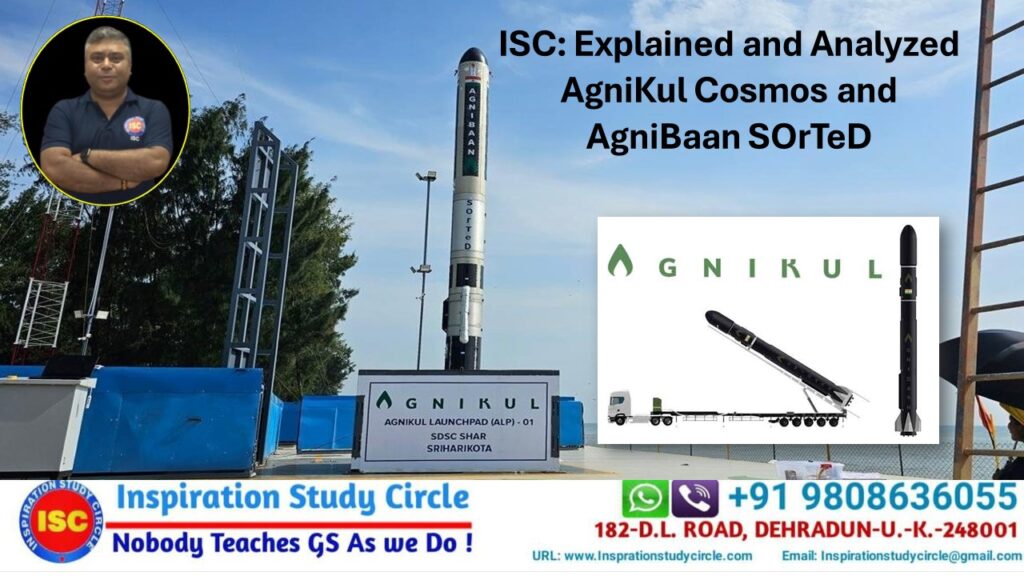
UPSC 2026 Notification Postponed
UPSC 2026 Notification Postponed Table of Contents UPSC 2026 Notification Postponed UPSC Exam 2026 is an All-India Civil Services Exam
AgniKul Cosmos and AgniBaan SOrTeD
Indian space startup Agnikul Cosmos on 30th, May 2024 successfully grounded its first suborbital test vehicle with the world’s first integrated 3D-printed rocket engine, after at least four previous launches.
Agnibaan SOrTeD (Subsidiary Technology Demonstrator) was launched at 7:15 am on May 30th in the first mission ever. This is the second launch by a private Indian startup, but the first using a private launch pad installed by the company at Sriharikota, the country’s only operational airport.
The Indian Space Research Organization (ISRO) also congratulated Agnikul in a post on X, saying it was “a major milestone, as the first controlled flight of a semi-cryogenic liquid engine through additive manufacturing has been realized”.

AgniKul Cosmos Private Limited[a] is an Indian aerospace manufacturer based at the National Center for Combustion Research and Development (NCCRD), IIT Madras, Chennai. The startup aims to develop and launch its mini-launcher, such as the Agnibaan, which can place a 100-kilogram (220-pound) payload into a 700-kilometer (430-mile) orbit.
The company was founded with seed capital by Srinath Ravichandran, Moin SPM, Satyanarayanan Chakravarthy, and Janardhana Raju at IIT Madras.
In September 2021, Agnicol signed a framework agreement with the Ministry of Space to access ISRO’s facilities and technical expertise to develop a two-stage small satellite launch vehicle ‘Agniban’. On November 7, 2022, Agnikul Cosmos acquired its first Flight Termination System (FTS) from ISRO.
Agnikul Cosmos inaugurated India’s first private launch pad and mission control center at the Satish Dhawan Space Center (SDSC) in Sriharikota, Andhra Pradesh on November 28, 2022. The launch pad and mission control center are 4 km away. Currently, the launch pad can accommodate liquid-stage rockets. All the critical systems performing functions at the Agnikul Launch Pad (ALP) and the Agnikul Mission Control Center (AMCC) have a high degree of redundancy to ensure 100% efficiency. The facilities are supported by ISRO and the Indian National Space Propulsion Validation Center (IN-SPACE).
|
Company Type |
||
|
Industry |
||
|
Founded |
2017 (7 years ago) |
|
|
Founder |
|
|
|
Headquarters |
National Centre for Combustion Research and Development, IIT Madras, Chennai, Tamil Nadu, India |
|
|
Key people |
||
Agnibaan (Devanagari: अग्निबाण, ISO: Agnibāṇa) (lit. “Arrow of Fire”) is envisioned as a mobile launch system capable of placing a 100 kg (220 lb) satellite at 70 miles or 70 km. The missile will be 18 meters long, 1.3 meters in diameter, and have a launch mass of 14,000 kilograms (31,000 pounds). We use cluster engines in the first stage in various configurations depending on the load and use only LOX and kerosene engines. [20] The single-stage suborbital demonstrator, nicknamed Agnibaan SOrTeD (Suborbital Technology Demonstrator), was successfully launched on 30 May 2024 as a suborbital test flight.
Agnibaan SOrTeD is a configurable launch vehicle that can be launched in one or two stages. It is powered by AgniKul’s patented Agnilet engine, a 6-kilonewton (kN) 3D printed semi-cryogenic engine that uses liquid oxygen and kerosene as propellants.
Unlike traditional sounding missiles launched from guide rails, Agnibaan SOrTeD takes off vertically, follows a predetermined trajectory, and performs precisely coordinated maneuvers during flight. It can carry payloads of up to 100 kg up to an altitude of 700 km in five different configurations.
Agnibaan SOrTeD is the first step in launching the world’s first 3D-printed rocket into space.
3D printing or additive manufacturing is the creation of 3D objects from CAD or digital 3D models. This can be done by various processes that deposit, bond, or solidify materials under computer control, usually adding materials layer by layer (such as melting plastic, liquid, or powder particles).
This is the opposite of subtractive manufacturing, which involves cutting or hollowing out metal or plastic parts using something like a milling machine. 3D printing is traditionally used for prototyping and has wide applications in the production of artificial organs, stents, dental veneers, automotive parts, consumer goods, and more.
As of 2020, 3D printers have reached a level of quality and price that allows most people to enter the world of 3D printing. Affordable printers are usually fused deposition modeling (FDM) printers. In April 2024, the world’s largest 3D printer, Factory of the Future 1.0, was unveiled at the University of Maine. You can create an object 96 feet or 29 meters long. In 2024, researchers used machine learning to improve the structure of artificial bones and set a record for shock absorption.
Advantages of 3-D Printing: Additive manufacturing or 3D printing is rapidly gaining importance in the field of engineering due to its many advantages. The vision of 3D printing is the freedom to design, individualize, decentralize, and execute processes that were previously impossible with alternative methods. These benefits include faster prototyping, lower manufacturing costs, increased product customization, and improved product quality.
Additionally, 3D printing capabilities extend beyond traditional manufacturing, including lightweight structures and maintenance in applications such as prosthetics, bioprinting, food industry, rocketry, design and art, and renewable energy systems. 3D printing technology can be used to produce battery energy storage systems that are essential for sustainable energy generation and distribution.
Another advantage of 3D printing is the ability of this technology to make complex shapes with high precision. This is particularly relevant in the field of microwave engineering, where 3D printing can be used to produce components with unique properties that are difficult to achieve using traditional manufacturing methods.
It is not clear when 3D printing technology entered India, but the first mention of 3D printing in India was when the company Imaginarium started manufacturing jewelry using 3D printing technology. 3D printing is rapidly being used in many industries in India including the medical, automotive, jewelry, and construction sectors. Industry uses this technology to save time, materials, and costs.
3D printers have revolutionized manufacturing in India. Industries such as construction, jewelry, medicine, automotive, and aerospace use 3D printing to save time, money, and resources. The Indian government plans to add 100 new 3D printing startups by 2025. India aims to develop 50 new technologies to advance 3D printing in the industry. India estimates that this new technology will create 100,000 new jobs in India. The Indian government plans to produce 500 new products using 3D printing technology by 2025.
An Indian housing company is developing technology to build homes using 3D printers that will help reduce costs and improve sustainability. India’s medical industry uses 3D printing technology to produce products such as organs and tissues to support research and train doctors. It is estimated that the medical industry accounts for 20% of the 3D printing industry worldwide.
This is not the first time that a private Indian company has launched a missile from Indian soil. In November 2022, Skyroot Aerospace, a young space startup like Agnikul, announced the launch of a rocket named Vikram, named after legendary space leader Vikram Sarabhai, who is said to have helped build ISRO in its early days. This moment was welcomed by the president, prime minister, and many others.
All of these target the small satellite market, with growing demand for a variety of space applications in diverse fields such as communications, broadcasting, disaster management, climate change, earth and ocean observation, urban planning, and surveillance. Space exploration or scientific experiments are not considered.
The fact that Agnibaan was launched from a private launch pad is a first for India. So far, all space launches have taken place from one of ISRO’s two launch pads at Sriharikota. As the number of space launches is expected to increase rapidly, ISRO is developing a second spaceport at Kulasekarapattinam in Thoothukudi district of Tamil Nadu. It is originally intended for SSLV setup.
With the entry of private companies, space has become an emerging field that the government is focused on promoting. Prime Minister Modi held several personal meetings with a select group of space entrepreneurs. Space has become an important part of India’s diplomatic activities in other countries and is expected to grow at a very high rate in the short and medium term as well as other companies using its capabilities for their needs where possible.

UPSC 2026 Notification Postponed Table of Contents UPSC 2026 Notification Postponed UPSC Exam 2026 is an All-India Civil Services Exam

Inspiration Study Circle- Best UPSC 2027 Coaching Table of Contents Inspiration Study Circle- Best UPSC 2027 Coaching UPSC Exam 2027

Buddha Relics Return to India after 127 Years “How India Pulled off a Swift Repatriation?” Table of Contents In January 2026, India

Explained: What is happening in Venezuela? Table of Contents Explained: What is happening in Venezuela? In January 2026, Venezuela is experiencing

ISC Explained: Manual Scavenging in India Table of Contents ISC Explained: Manual Scavenging in India Manual scavenging in India is a

The SHANTI Act 2025 Table of Contents The SHANTI Act 2025 The Sustainable Harnessing and Advancement of Nuclear Energy for Transforming